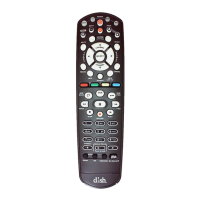R
E
M
OT
E
A
N
T
E
N
NA
R
E
M
OT
E
A
N
T
E
N
NA
23
Avoiding RF Interference
Because your remote control uses UHF 2G (2.4
GHz ISM band) radio frequencies (RF), you
might experience interference from other devices
transmitting nearby. The instructions in this section
describe how to avoid such conicts.
Ensure the UHF 2G remote
antenna is connected to the correct
input on the Hopper’s back panel
and is not touching anything.
Tighten only by hand.
Vary the tilt angle of the Hopper’s
remote antenna, locating the
antenna’s tip away from any other
electronic equipment or metal
surfaces, even if separated by
wooden shelving.
Move the Hopper and/or Joey to
a different location. Place them
on as high a surface as possible,
above all other equipment in your
entertainment center.
Use the optionally available special
cable to connect the remote
antenna to the Hopper and place it
away from other equipment.
Move any nearby antenna or radio
equipment away from the Hopper
and/or the Joey. Do not place
an over-the-air antenna, WiFi,
Bluetooth, or Zigbee devices on or
near either the Hopper or the Joey.
2
3
4
Adjusting the Antenna
The Hopper communicates with its remote control(s)
through an UHF 2G antenna connected to the
Remote Antenna input on it’s back panel.
Note: This remote antenna can only be used with
UHF 2G capable receivers.
5
1

